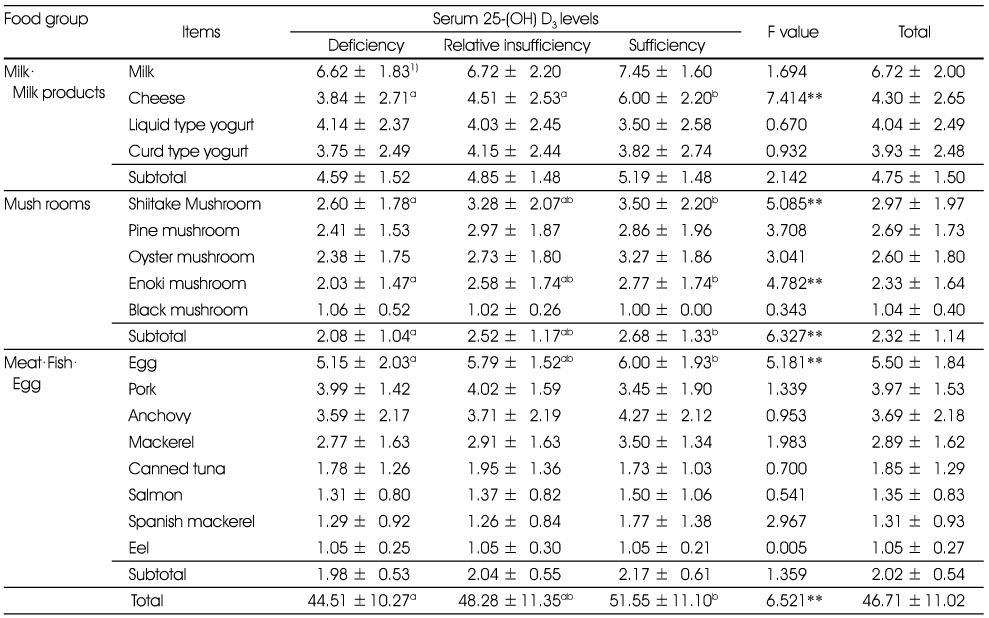References
1. Ahn HS, Um SS. Dietary intakes of infants and young children in Seoul area. J Korean Soc Matern Child Health 2003;7(2):179–191.
2. Lee HJ, Kim YA, Lee HS. The estimated dietary fiber intake of Korean by age and sex. J Korean Soc Food Sci Nutr 2006;35(9):1207–1214.
3. Pyo SH, Kang HJ. A study on the actual state of nutrition knowledge, dietary attitude, eating behavior, physical ability and locomotion of children aged 5 years in Siheung-city. Korean J Food Nutr 2014;27(5):760–770.
4. Choi MJ. Bone health and calcium, vitamin D, potassium: shortfall nutrients in Korean. Korean J Obes 2013;22(3):129–136.
5. Yu A, Yang YJ, Jeong SR, Kim JH, Kim YJ, Kwon OR. Calcium intakes in Korean and American populations. J Korean Diet Assoc 2013;19(1):46–58.
6. James LG, Sareen SG. Advanced nutrition and human metabolism 3rd edth ed. California: Wadsworth; 1999. p. 373.
7. Chung YS, Yoo BW, Oh JE, Lee DC, Lee HS, Cho CY. The relationship between vitamin D levels and chronic diseases. Korean J Clin Geriatr 2010;11(2):154–169.
8. Shin MY, Kwun IS. Vitamin D revolution: Is it a vitamin or a hormone? Food Ind Nutr 2012;17(2):1–6.
9. Yang HR, Seo JW, Kim YJ, Kim JY, Ryoo E, Sim JG. Recent concepts on vitamin D in children and adolescents. Korean J Pediatr 2009;52(10):1082–1089.
10. Na B, No SJ, Kim MJ, Han HS, Jeong EH, Han YH. Nutritional status of vitamin D in Korean mothers and their newborn infants. Korean J Perinatol 2007;18(4):399–406.
11. Park Y. Vitamin D and atopic dermatitis. Allergy Asthma Respir Dis 2013;1(3):197–202.
12. Holick MF, Binkley NC, Bischoff-Ferrari HA, Gordon CM, Hanley DA, Heaney RP. Evaluation, treatment, and prevention of vitamin D deficiency: an endocrine society clinical practice guideline. J Clin Endocrinol Metab 2011;96(7):1911–1930.
13. Ross AC, Manson JE, Abrams SA, Aloia JF, Brannon PM, Clinton SK. The 2011 report on dietary reference intakes for calcium and vitamin D from the institute of medicine: What clinicians need to know. J Clin Endocrinol Metab 2011;96(1):53–58.
14. Yu A, Kim JH, Kwon OR, Oh SY, Kim JH, Yang YJ. Associations between serum 25-hydroxyvitamin D and consumption frequencies of vitamin D rich foods in Korean adults and older adults. Korean J Community Nutr 2014;19(2):122–132.
15. Kim SN, Kim SH. A survey on use of vitamin, mineral supplements by children in Daejeon city and Chungcheong province in Korea. Korean J Food Cult 2010;25(2):117–125.
16. Lee HS, Han JH, Kim SH. A survey on the consumption of vitamin and mineral supplements as health functional foods and related factors by Korean adolescents. Korean J Food Cult 2013;28(4):415–423.
18. The Korean Nutrition Society. Dietary reference intake for Korean 2nd edth ed. Seoul: The Korean Nutrition Society; 2010. p. 165–178.
19. Kim YJ, Moon MS, Yang YJ, Kwon OR. Relationship between serum 25-hydroxyvitamin D concentration and the risks of metabolic syndrome in premenopausal and postmenopausal women. Korean J Nutr 2012;45(1):20–29.
20. Ronni C. Geriatric nutrition : A health professional's handbook 4th edth ed. America: Jones & Bartlett Publishers; 2013. p. 39–43.
21. Yoo HN. Related factors of vitamin D deficiency and metabolic syndrome in children and adolescents - based on Korea National Health And Nutrition Examination Survey V, (KNHANES) ??[master's thesis] Hanyang University; 2013.
22. Yoon JS, Song MK. Seasonal differences in outdoor activity time and serum 25-(OH) vitamin D status of Korean young women. Korean J Community Nutr 2014;19(3):231–240.
23. Kim YJ, Lee JS. Association of vitamin D status with acute lower respiratory infection in children. Pediatr Allergy Respir Dis 2010;20(3):173–178.
24. Baek JU, Hwangbo JW, Lee HR, Lee SY. Vitamin D insufficiency is associated with food sensitization in children under 2 years with atopic dermatitis. Allergy Asthma Respir Dis 2013;1(3):211–215.
25. Shin YH, Park JH, Sung MS, Kim SW. Correlation between serum 25-hydroxyvitamin D levels and severity of atopic dermatitis in children. Allergy Asthma Respir Dis 2014;2(2):114–121.
26. Bedner M, Lippa KA, Tai SSC. An assessment of 25-hydroxyvitamin D measurements in comparability studies conducted by the Vitamin D Metabolites Quality Assurance Program. Clin Chim Acta 2013;426(15):6–11.
27. Kim HJ, Kim EH. Comparison of chemiluminescence immunoassay (CIA) and immunochromatography assay(ICA) for Detecting HBsAg and Anti-HBs. J Korea Acad Ind Coop Soc 2013;14(7):3419–3424.
28. Ministry of Health and Welfare, Korea Center for Disease Control and Prevention. Korea National Health And Nutrition Examination Survey(KNHANES -1) [Internet] 2014. cited 2015 Mar 19. Available from:
https://knhanes.cdc.go.kr/knhanes/index.do/.
29. National Academy of Agricultural Science. Functional ingredient list of food-Vitamin D [Internet] 2015. cited 2015 Mar 23. Available from:
http://koreanfood.rda.go.kr/.
31. Kwak MK, Kim JH. The radiative characteristics of EUV-B over the Korean peninsula and exposure time for synthesizing adequate vitamin D. Atmos. J Korean Meteorological Soc 2011;21(1):123–130.
32. Hyun HJ, Kim JH, Ko GY, Park BS, Choi EY, Ahn MH. The relationship among sun-screening agent use, bone health promotion behavior and bone mineral density of female college students. J Korean Biol Nurs Sci 2013;15(4):202–209.
33. Kim MY, Yoon CS. The research on the ultraviolet protector recognition of the adult and propensity to consume. J Beauty Ind 2014;8(1):63–84.
34. Kang JH. The relationship between vitamin D levels and extraskeletal disease [master's thesis] Seoul National University; 2013.
35. Shin ES, Kim EJ, You YE. A study on the spatial configuration and uses of kindergartens outdoor playground. Soonchunhyang J Hum 2012;31(2):200–228.
36. Choi HJ. New insight into the action of vitamin D. Korean J Fam Med 2011;32(2):89–96.








